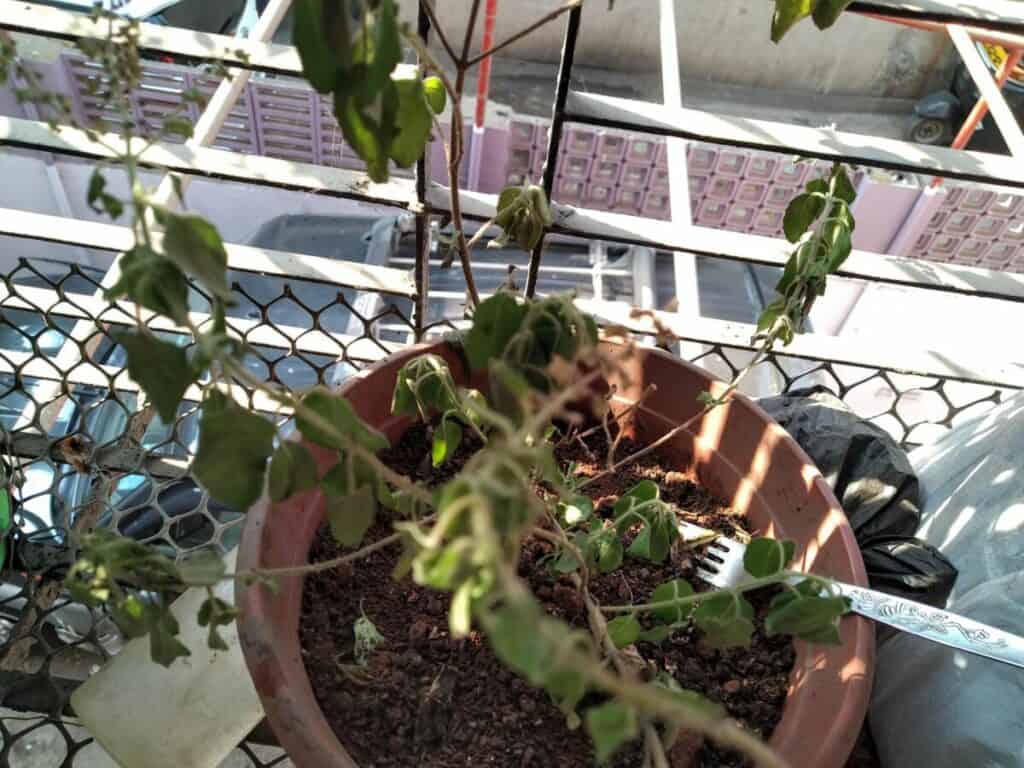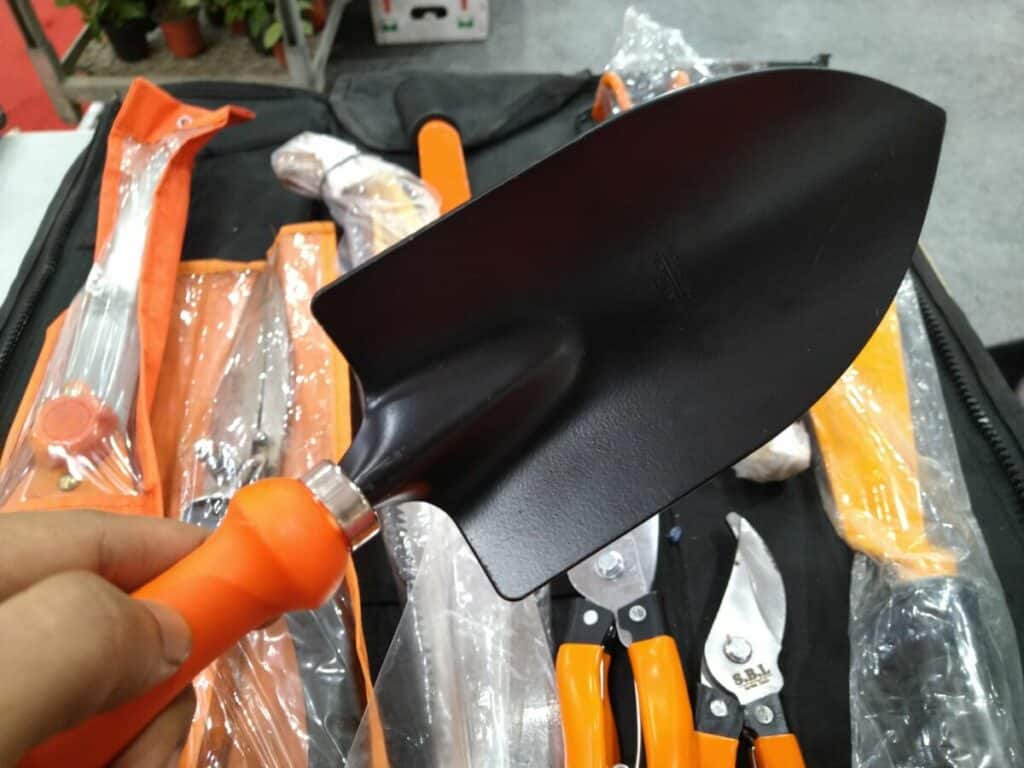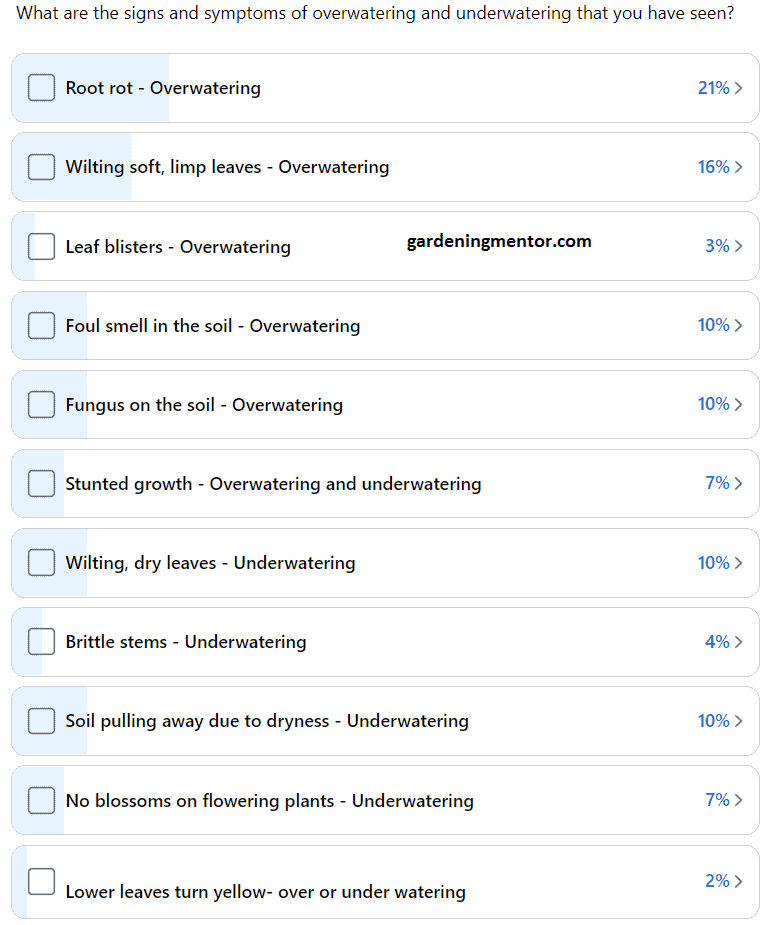It can be a big challenge for a beginning gardener.
Many symptoms for overwatering or underwatering your plants see similar and it can cause plenty of confusion.
You don’t want to give an overwatered plant more water. And it’s not good to avoid giving water to a plant that is underwatered.
So how to recognize the difference?
You can tell the difference between underwatering and overwatering by checking the soil. If the soil is overwatered, it will be wet and if the soil is underwatered, it will be dry. An overwatered plant’s leaves will wilt becoming soft and limp. An underwatered plant’s leaves will be dry and yellowing.
I’ve written a lot more details below that will help make it clear how to identify the overwatering or underwatering problems in your plants. I’ll also give you solutions on how to solve the issues your plants are having.
Let’s get started.
1. Rotting roots
This is the most common symptom of overwatering your plants. The soil in your container requires space for air and moisture to reach the roots.
If there’s too much water in the soil, it blocks these pathways and spaces. This chokes the roots, as air does not reach them and they rot because of fungal diseases.
Dig a little into the soil until you can see the roots. If they appear black, soggy, and smell, that’s a sign of root rot due to overwatering.
2. Wilting leaves that are soft and limp
Because of overwatering, the roots are getting choked. They cannot deliver the nutrients to the foliage. So the leaves will start wilting, but this could happen with underwatering as well.
But with overwatering, the wilting leaves will appear soft and limp. That’s because the excess water is also getting pushed to the leaves. With underwatering, the wilting leaves will appear dry and crisp because of a lack of required moisture.
3. Leaf blisters
The excess water, because of overwatering, may also cause leaf blisters as it reaches the stems and leaves. The water bursts out of the leaves because of the excess stress on them.
If you notice that your plant’s stems are soft and squishy, it’s likely that you’re overwatering. This happens because the plant is taking in too much moisture. It then starts to puff up and lose firmness. If the soil is also wet to the touch, you’ll want to cut back on watering. – Jeremy Yamaguchi, CEO of Lawn Love
4. Foul smell from the soil
A lot of water in the soil means the roots don’t get to breathe. But this also means it becomes a thriving ground for many fungi.
These fungi will thrive in the soil on the dead material like dried leaves, branches, but also the plant roots. Typically, this results in a smell because of the decaying of the material.
I asked fellow gardeners what are the signs and symptoms they observe for overwatering and underwatering. Below are the results of this survey.
5. Fungus on top of the soil
Sometimes the fungi that is active in the moist conditions of overwatering appear on the soil surface. You may see the signs and symptoms of such fungi such as white, green, yellow, black materials and spores on the soil.
Some of these fungi may be harmful to the plant, while others are harmless. Some may even attract other diseases or pests to the plant.
6. Stunted and slow growth
This can be a symptom of either underwatering or overwatering. The lack of water will cause a lack of nutrients reaching the plant.
The excess water will block the roots and they won’t be able to send the nutrients from the soil to the plant.
This is the one of the first signs to understand about underwatering or overwatering. But you need to check some of the other signs to narrow down what the issue is.
Signs of underwatering the plants include yellow or brown spots on foliage, wilting leaves, dry and crumbly soil, and shriveled and dry roots. Also, when you go to water the plant, notice the speed at which it is taking in the water – faster may indicate that it is dehydrated. On the other hand, overwatering can result in root rot and slowed growth, as well as signs such as droopy leaves, root-bound soil, an excessively damp surface soil layer, fungus growth on the plant’s leaves and stem, and more discolored foliage. – Cynthia Drachenberg, Founder at CynthiaDrachenberg.com
7. Wilting leaves that are dry and crisp
Wilting leaves can be a symptom of both underwatering and overwatering the plants. The leaves may turn yellowish or brown.
But with underwatering, the leaves will be dry and crisp instead of soft and limp.

8. Brittle stems
Too little water reaching the stem is a problem of underwatering. And the result is that the stem will turn brittle. Have a look at the stem or touch it to understand whether it’s dry and brittle.
9. Soil pulling away from edge of the container
When you’re growing plants in a container and underwater it, the soil will compact.
As part of this problem, the soil will pull away from the edge of the container. This is an easy and common symptom to spot when underwatering is the issue.
10. No blossoms on flowering plants
You may find a lack of blossoms on flowering plants because of underwatering or overwatering. So it’s not possible to know the exact problem without looking at some other symptoms.
You can use this as a starting point to understand something is wrong with the plant. But then take the next step of further diagnosis if it’s watering issues, pest or disease problems, or some environmental issues.
I find that wilting leaves with limp or dry conditions, moisture in the soil, and the root health are good symptoms that make it clear if it’s an underwatering or overwatering problem.
How to solve the problem of underwatering?
Looking at the symptoms I mentioned above, you may find that your plant is suffering from underwatering.
The first thing to do is prune the wilting or dead leaves and branches from the plant, as they serve no purpose.
Before you add water to the soil, check the condition. Maybe the soil has been dry for very long and it won’t absorb moisture well.
If that’s the case, I would suggest you use a trowel and loosen the soil at the 2-inch level so it can get back its texture.

Give a good watering to the soil until it’s well absorbed. If the plant is in a container, water the potting soil until the water drains out from the drainage holes at the bottom.
Then wait for a few minutes and repeat the process. Water the soil or potting soil well so it can absorb moisture and regain it’s texture.
Wait for a few minutes and repeat the process for the third time. This will bring the soil back to its original form.
Cbeck soil dampness by poking your finger into the soil to the first knuckle on your index finger. If it’s dry, then you can water. If it’s still moist, then hold-off.
Always use well drained soil regardless if plants are growing outside or in pots/containers. Drainage is so important to ensure plant roots don’t get water-logged. Applying a layer of straw mulch will also help prevent water evaporation and keep the soil moist and fluffy for longer. – Sandra Nanka, Gardening and Herb Expert at Mudbrick Herb Cottage
How to solve the problem of overwatering?
Once you know your plants are suffering from the problem of overwatering, you can fix it with a few steps.
Dig into the soil and check if the roots are black, soggy, and smell which is a sign of root rot. If that’s the case, you need to dig out the plant from the soil. Then cut off the diseased roots while keeping the white, healthy ones.
Use clean garden shears or scissors to cut them off. Sterilize them with rubbing alcohol before use. If all the roots are diseased, you won’t be able to save the plant and it needs to be disposed.
If the plant has withered, limp leaves, you can trim them off the plant. If the soil has fungus on the surface or smells bad, you need to ensure it gets good sunlight. This will dry out the soil and remove the fungus that is causing the problems in the soil. Make sure you don’t water the soil until it is completely dry.
To prevent a plant from suffering from water-related stress and issues, its care needs and preferences would need to be met. For example, it is important to always use a potting media that is suitable for the specific plant species, i.e. a rich hummus-based potting soil, for example, will hold moisture for too long and is not suitable for cacti and succulents. Another thing to avoid over-or-underwatering plants is to avoid irrigation on a fixed schedule. Light, temperature, humidity, and seasonal changes are all variables that will affect how often a plant needs to be watered. That’s why it’s always best to regularly check whether your plant needs a drink by either using a moisture meter or by testing the top two inches of the potting media with your index finger. – Kevi Tara, Owner at LEAFnJOY
How to prevent overwatering or underwatering?
I know it sucks when your plant suffers from overwatering or underwatering. And it’s more work for you to recover the soil and plant back to its healthy levels. So the best thing to do is prevent these issues from occurring.
It’s actually easy to avoid overwatering or underwatering problems if you know the basics of watering your plant.
First, understand the watering needs of your plant. Different plants can have different requirements. Some may need more water than others.
How much water you add to the soil also depends on the weather. You may need to water more often in summer than fall or winter.
What works for me is to check the soil every morning as part of my daily routine. If I see that the soil looks dry on the surface, I will stick my finger 1-2 inches inside.
When I take my finger out and there is no soil stuck to it, that’s a sign the soil has become dry and needs a good watering. If there is some soil stuck to the finger, I know there’s still some moisture in the soil and no need to water it just yet.
One way is to check the soil moisture.. If the top few inches of soil are dry, then your plants need water. Another way is to look at the leaves. wilted leaves are a sign that your plants need water. If you’re not sure whether or not your plants need water, err on the side of caution and give them a little bit less rather than more. Overwatering is one of the quickest ways to kill plants, so be careful! – Kellan MacKay, Owner of Khela Herbs
Another thing I like to see when watering is that the water is getting well absorbed in the soil and not running off. If the plant is in a container, I inspect the water slowly trickles out from the drainage holes. This shows that the soil texture is good and the drainage holes are working well.
This will prevent overwatering issues where the moisture does not drain out from the soil for a very long time, either because of the soil texture or because of the blockage in the drainage holes.
Fact Checked, Written, and Published by Kevin Rodrigues
Kevin is the founder of Gardening Mentor, a website that aims to teach people to grow their own food in a limited space. As a self-taught gardener, Kevin has spent several years growing plants and creating gardening content on the website. He is certified in Home Horticulture and Organic Gardening from Oregon State University. He has a Post Graduate Diploma in Horticulture and Landscape Gardening from Mumbai University.
Read more


